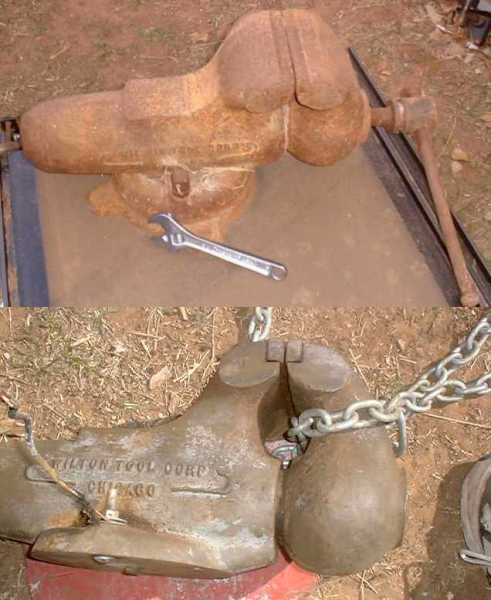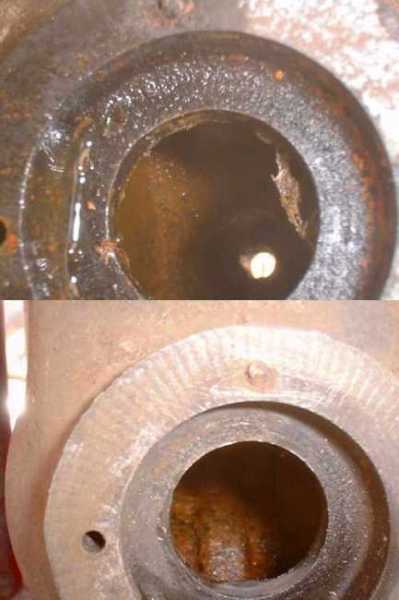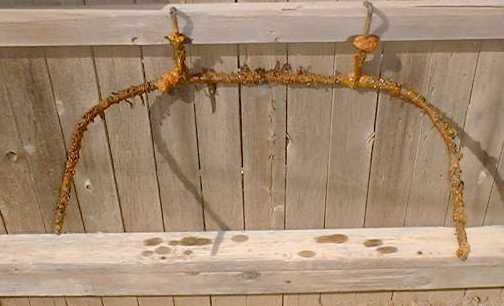|
show & tell 48 hours
 posted
by Cutter 03-11-2004 posted
by Cutter 03-11-2004
quote:
--------------------------------------------------------------------------------
Originally posted by Newb
When we getting an update Cutter? Your wife didn't serve you that for
dinner did she?
--------------------------------------------------------------------------------
Newb,
The last thing my wife served me were the walking papers - ten years ago.

Here is a combined shot of the vise to show some contrast & give you an
idea of the rate
of progress. The top is the original condition, the lower was taken at
about 44 hrs into
the process. I used a hand brush very quickly on it & discovered some of
the factory paint.
If I were only interested in the appearance, I could probably finish it
off with a wire wheel
at this point but the sliding section is still frozen. This picture was
taken 2 days ago; I hauled
it out & checked it yesterday - still stuck. I was in a rush to leave for
work so didn't bother with
more photos.

This a detail of the front of the
sliding section at the 18 hour mark on top and the lower was
taken at about 44 hours. You can also see right down the gullet. I am
beginning to doubt that
I will be able to budge the jaw until I either buy or fabricate the collar
so I can use the screw
to back the jaw out. No time for that right now. However if anyone still
doubts whether
the process will remove rust, this 2nd picture should be proof enough.

Thanks OP. I did a google search, found
an email address that seemed to match, sent an
inquiry & got an "unable to deliver" back right away. When time permits
maybe - very late
to work as it is. Good thing I own my own time clock.
posted by: Jim314
cutter, I'm really enjoying this thread
and watching your progress on the vise.
____Jim314's signature_______________
Jim
Lincoln AC Buzzbox
HH 175
show & tell continues
 posted
by Cutter 03-12-2004 posted
by Cutter 03-12-2004
quote:
--------------------------------------------------------------------------------
Originally posted by Jim314
cutter, I'm really enjoying this thread and watching your progress on the
vise.
--------------------------------------------------------------------------------
Thank you, Jim.
I am enjoying it too despite not really having any daylight time to spend
on it during the week. I can usually spare a few minutes in the mornings
but rarely get in before dark. About all I have time for then is to clean
the rebar off & fire it back up.
About that rebar: I started this project off using 3 pieces about 10
inches long, tacked together with coathanger as the anode connected to the
battery charger's positive lead. Within hours, the coathanger had rusted
in two. So I found a piece of rebar about 4 feet long and stomped it into
a rough U-shape & welded two of the short sticks to it, pictured below.
The short pieces already had a sharp hook bent on one end so they could
hang over the sides of the tub & suspend the U several inches off the
floor. This has worked much better but is probably still less sacrificial
metal than optimum because the current flow really slows down after about
12 hours. The battery charger's meter is probably very inaccurate but
still is useful as a reference in that it shows a current draw of about 7
amps at startup & that drops to about 2 amps after 10 or 12 hours or
whenever the anode gets heavily coated, as in the picture. So the process
needs some tending & can't just be left alone for a week at a time without
having the efficiency really suffer. All I have to do is wire brush the
rusty slop off the rebar and hook it back up in the tank. Its messy but
quick.
Even though it is obvious, I feel I should stress that polarity is a
critical issue in this process. Always connect the negative lead to the
part you want to de-rustify and the positive to the sacrificial anode.
Otherwise you will reverse the process and screw up the thing you are
trying to save. Simply put, remember that electrons flow from negative to
positive & carry the rust with them because positive attracts.

posted by:
pjt
Showed this to one of the guys at
work-we're ready to try it. What do we use for the solution? Soap powder?
What kind? Is that what TSP is? (Is that Tri sodium Phosphate?)If it
is,what am I looking for in the store(Namebrand?)
Question 2: Does this work for sheet metal? Will it be damaged if it stays
in too long?
 posted
by Cutter 03-12-2004 posted
by Cutter 03-12-2004
quote:
--------------------------------------------------------------------------------
Originally posted by pjt
Showed this to one of the guys at work-we're ready to try it. What do we
use for the solution? Soap powder? What kind? Is that what TSP is? (Is
that Tri sodium Phosphate?)If it is,what am I looking for in the
store(Namebrand?)
Question 2: Does this work for sheet metal? Will it be damaged if it stays
in too long?
--------------------------------------------------------------------------------
I am using Arm & Hammer Super Washing Soda which differs from baking soda.
It is sodium carbonate
rather than sodium bicarbonate. Here are links to a couple of the first
articles I ever read about it a
year or two ago:
http://www.stovebolt.com/techtips/rust/electrolytic_derusting.htm
http://www.owwm.com/FAQ/electrolysis.asp
They should answer most questions you can think of.
posted by: fla jim
OOPS!
Cutter, you got it reversed. The item your derusting (the negative
connection) is the anode. The Rebar (the positive connection) is the
Cathode. The Electron flow from - to+ strips the oxidation from the anode
and deposits it on the cathode.
I've dealt with "Cathodic protection in water tanks, where an electric
current is set up between an anode and the tank wall (Cathode) to keep the
tank wall from corroding. If you go to inspect the tank, and forget to
turn off the cathodic protection, It will light up your day, about 90
volts D.C. 
posted by: atucker
OOPS! to the OOPS! - I hope we aren't
starting another GREAT DEBATE here. From my GuruNet online dictionary:
From my GuruNet online dictionary:
an·ode (ăn'ōd')
n.
1. A positively charged electrode, as of an electrolytic cell, storage
battery, or electron tube.
2. The negatively charged terminal of a primary cell or of a storage
battery that is supplying current.
cath·ode (kăth'ōd')
n. (Abbr. ka)
1. A negatively charged electrode, as of an electrolytic cell, a storage
battery, or an electron tube.
2. The positively charged terminal of a primary cell or a storage battery
that is supplying current.
Geesh - this is one of those that when you first look at it, you say WHAT?
The way I read this, the stuff in the tank are the electrodes and
consequently the #1 applies in both cases. Oddly enough, I've worked in
electronics for many years and this is the first time I've seen the #2
definitions, which are referring to the power SOURCE.
Amazing what we can learn each day .
The more I read this the more I'm CONFUSED

Allen T.
posted by: Franz
SCRAP the REBAR, use old lawnmower
blades if you want to go cheap. For those who are really serious, CARBON
anodes cause the crud doesn't accumulate.
Polarity is real simple, when you have the polarity right you see bubbles
rising from the object your derusting.
ARM & Hammer washing soda, 1 tablespoon per gallon of water.
 posted
by Cutter 03-12-2004 posted
by Cutter 03-12-2004
quote:
--------------------------------------------------------------------------------
Originally posted by fla jim
OOPS!
Cutter, you got it reversed. The item your derusting (the negative
connection) is the anode. The Rebar (the positive connection) is the
Cathode. The Electron flow from - to+ strips the oxidation from the anode
and deposits it on the cathode.
I've dealt with "Cathodic protection in water tanks, where an electric
current is set up between an anode and the tank wall (Cathode) to keep the
tank wall from corroding. If you go to inspect the tank, and forget to
turn off the cathodic protection, It will light up your day, about 90
volts D.C..
--------------------------------------------------------------------------------
AAAACK! I got the terminology reversed? But at least the connections are correct.
That's what I get for posting before I wake up. Sorry about that.This is what I don't like about the 15 minute limit on editing posts.
But at least the connections are correct.
That's what I get for posting before I wake up. Sorry about that.This is what I don't like about the 15 minute limit on editing posts.
Maybe I can get Chuck to deal with this one for me. I used "anode" in
three places,
I believe. Sheesh!
Okay, I have sent a message to Chuck
asking him to correct my blunder but in a way that will
not make Fla Jim's & A Tucker's comments appear odd. In other words, I did
not ask him to
simply substitute "cathode" for "anode" but to somehow red flag the post
as containing the
error. If he chooses not to do it, I think you guys have probably covered
for me anyway.
Thanks for catching me.
Hmmm, as Allen T. said, now I am more
confused than before.
The article I was referring to
when I wrote my post also calls the positively charge part the "anode". I
think maybe
my mistake was really in using either term in this case.
http://www.owwm.com/FAQ/electrolysis.asp
I give up, late to work again. You guys can figger it out & let us all know.
You guys can figger it out & let us all know.
posted by: Franz
Breathe deeply Cutter. The confusion is
probably due to most people writing about electrolytic derusting using the
term anode or sacrificial anode when referring to the attracting element.
Hey, if it's on the internet it only has to be sorta correct some of the
time.
posted by: Ryel
quote:
--------------------------------------------------------------------------------
Originally posted by Franz
Hey, if it's on the internet it only has to be sorta correct some of the
time.
--------------------------------------------------------------------------------
or at least a good urban legend.



|

 posted
by Cutter 03-11-2004
posted
by Cutter 03-11-2004

